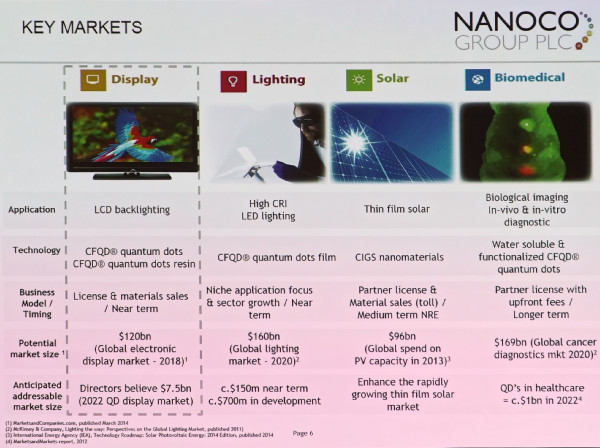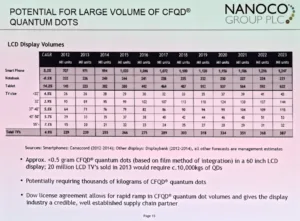Keith Wiggins is from Nanoco, the UK-based firm which has specialised in non-cadmium quantum dots. The company has 112 staff with more than 80 chemists. Wiggins believes that businesses that have a “sensory” impact have the best profits.
The Nanoco business strategy is based on market applications and early feedback from Japan was that materials should be cadmium-free, and now Wiggins said that its materials are close to cadmium-based in terms of performance.
The company plans to move to more of a delivery-based business rather than just IP development. In 2013, Nanoco signed a deal with Dow for manufacturing of its dots. As well as R&D in Manchester, UK, the company has a flexible manufacturing facility 30 miles from Manchester in Runcorn, UK.
Nanoco was recently listed on the full London Stock Exchange, which opens up its investor market and the company received £20 million of investment ($30 million) at the time.
The firm has 350 patents in process with around 80 granted.
Display is an early application for QDs, but there are lots of other applications in the future. High CRI LED lighting is a big one and solar is also interesting. There are also applications in medical in-vivo and in-vitro diagnostics.

Nanoco believes the QD material market in displays will be $7.5 billion in 2022.
Working with customers closely helps to develop technology and in Jan 2015, LG licensed Nanoco materials for its UltraHD TVs and the materials will be supplied by Dow.
Recently the European Parliament rejected an extension of the exemption for QDs under ROHS and Wiggins believes that other regions will follow. (There is controversy over this. The parliament did reject an extension, but pushed back the question for “further evaluation”, so it is possible that the question will come back before the parliament – Man. Ed.)
QD films need to be designed to use the cheapest blue LEDs, but still meet gamut requirements, in order to keep costs down. There is a lot of engineering needed to create good films that meet all the requirements of set makers.
There are big growth opportunities for up to 20 tonnes of QDs and Wiggins said that each 60″ TV takes less than half a gram of QDs, so 20 million sets of that size means a market for 10,000 kg.
Dow has a facility in Cheonan in Korea which will start to ship QDs in Q3 2015 under the Trevista brand.
Nanoco has a long term relationship with Osram to move QDs nearer to the LED chip. In many architectural spaces, high quality lighting is needed and there are a lot of application areas.
In solar panels, Nanocos has printable CIGS technology with a target module cost of $0.33/W.
In medical diagnostics, cadmium-free QDs, are not toxic, so surgeons can see the materials for up to 30 minutes, rather than a few seconds with traditional dyes. They can be used to study tumour development and behaviour

